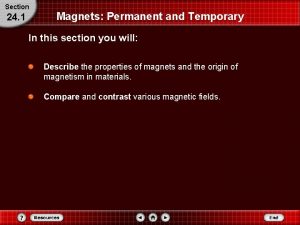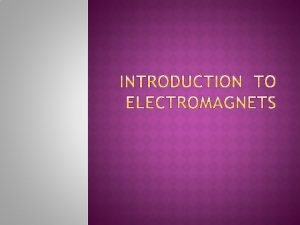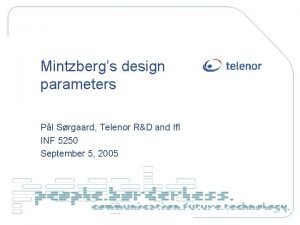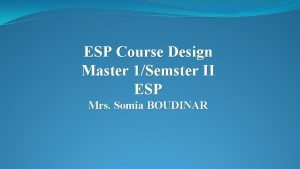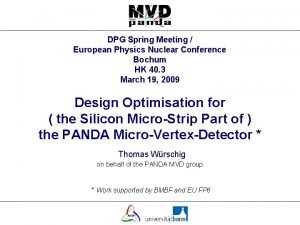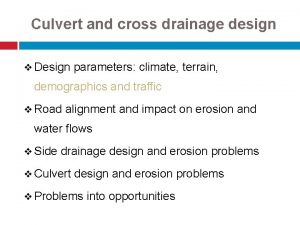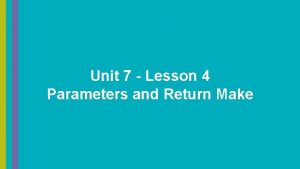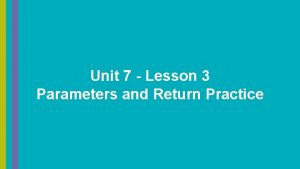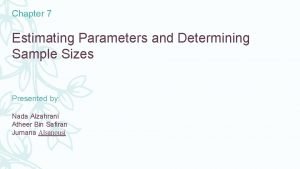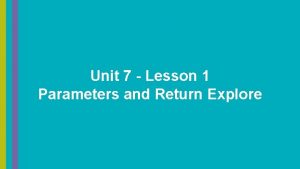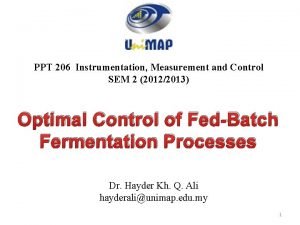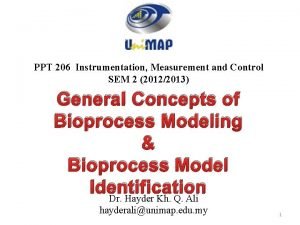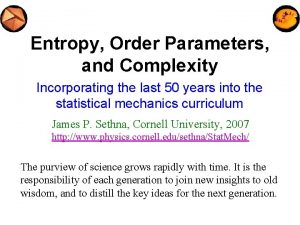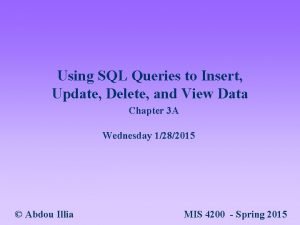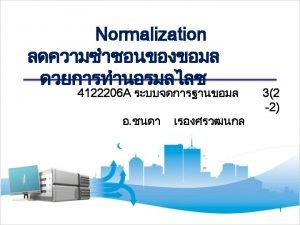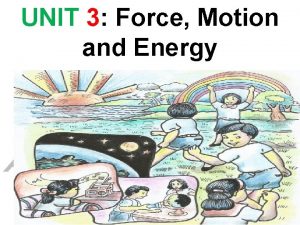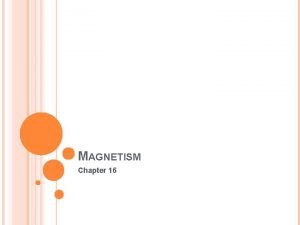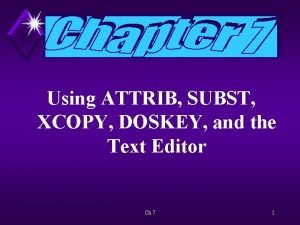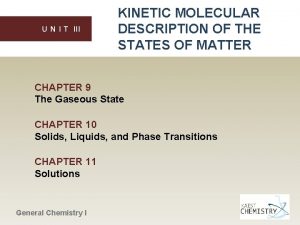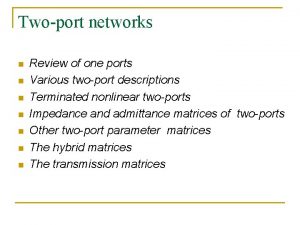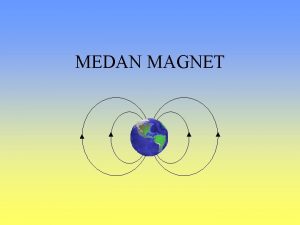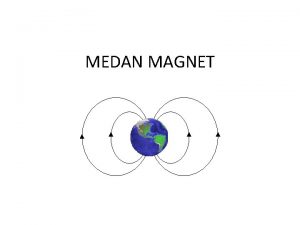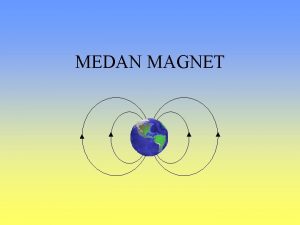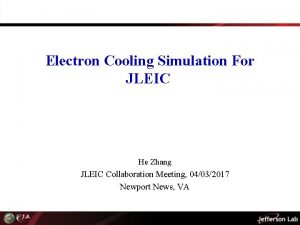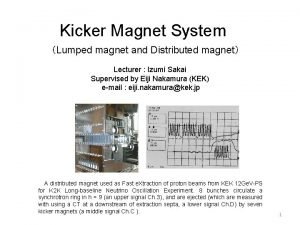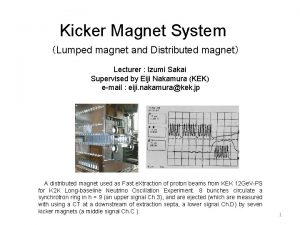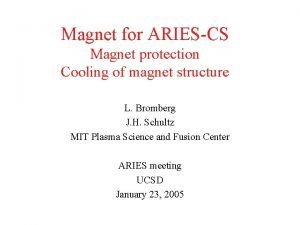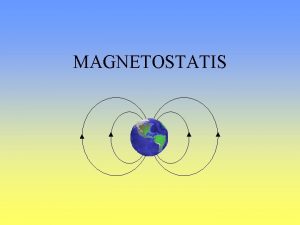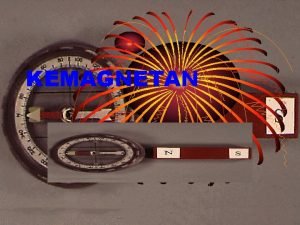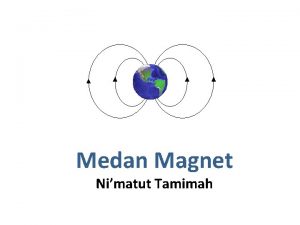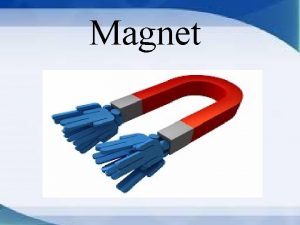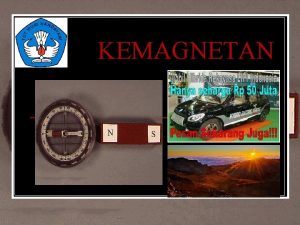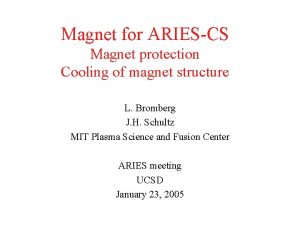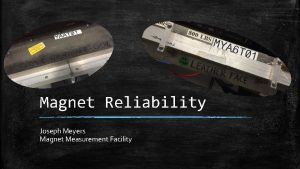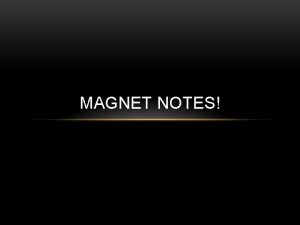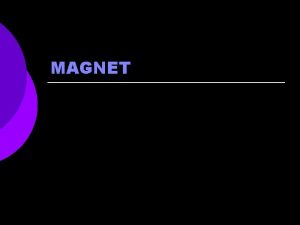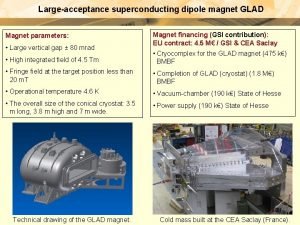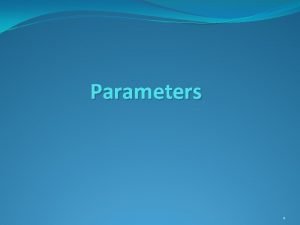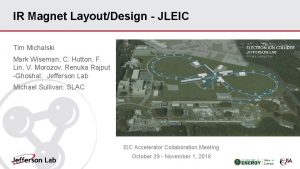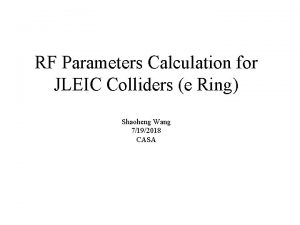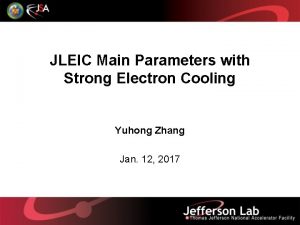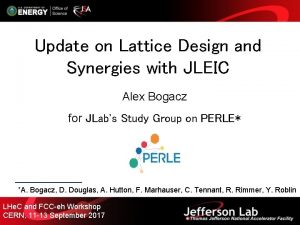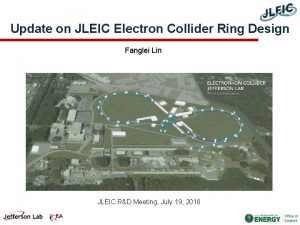Update on JLEIC IR Design and Magnet Parameters
























- Slides: 24

Update on JLEIC IR Design and Magnet Parameters Vasiliy Morozov on behalf of JLEIC design team JLEIC Collaboration Meeting April 1 -3, 2019

Full Acceptance Detector Concept • Would like to get ~100% acceptance for the whole event Solenoid Central Detector/ Ion bea Scattered Electron mli ne mline Electron bea Dipole d ar rw Fo Dipole n) (Io ct te De JLEIC Collaboration Meeting or Particles Associated with struck parton Particles Associated with Initial Ion 2 April 1 -3, 2019

Modifying IR Design for 200 Ge. V/c • Constraints -Maximum pole-tip fields at 200 Ge. V/c of 4. 6 T -Minimum impact on the forward hadron tagging performance compared to the 100 Ge. V/c design -Minimum impact on the luminosity performance compared to the 100 Ge. V/c design -Minimum impact on the beam dynamics compared to the 100 Ge. V/c design • Modification strategy -Increase the FFQ lengths to drop the pole-tip fields -Switch from a triplet to doublet final focusing configuration -First “quadrupole” in the doublet is two independent quadrupoles that can be run in a doublet mode up to 100 Ge. V/c JLEIC Collaboration Meeting 3 April 1 -3, 2019

Schematic of Full-Acceptance Detector • 50 mrad crossing angle End caps • Forward hadron detection in three stages -Endcap -Small dipole covering angles up to ~3 -Far forward, ~10 mrad, for particles passing through accelerator quads Secondary focus • Low-Q 2 tagger -Small-angle electron detection Central detector JLEIC Collaboration Meeting Roman pots 4 April 1 -3, 2019

JLEIC Interaction Region Layout • Most recent changes occurred in the ion IR due to redesign for 200 Ge. V/c ion momentum • Streamlined updates of GEMC and GEANT 4 detector region models • Continued development of an engineering design of the detector region IP Compton polarimetry forward e detection e ions forward ion detection dispersion suppressor/ geometric match spectrometers p (top view in GEANT 4) low-Q 2 electron detection and Compton polarimeter JLEIC Collaboration Meeting Forward hadron spectrometer 5 April 1 -3, 2019 e ZDC

Ion Interaction Region • High luminosity and acceptance performance in the whole energy range • Conventional Nb. Ti technology • Secondary focus with high dispersion JLEIC Collaboration Meeting 6 April 1 -3, 2019

Ion Beam Envelope & 99%p Trajectory • JLEIC Collaboration Meeting 7 April 1 -3, 2019

JLEIC Ion IR 100 Ge. V COM Design • ± 10 mrad angular aperture acceptance in the whole energy range up to 100 Ge. V COM with a secondary focus in combination with high dispersion point downstream of spectrometer dipole • Conventional Nb-Ti technology Final-Focusing Quadrupole technology • Same high luminosity and detection performance as the 65 Ge. V COM design • Shorter- and longer-focus configurations at lower and higher energies, respectively 65 Ge. V COM JLEIC Collaboration Meeting 100 Ge. V COM 8 April 1 -3, 2019

Ion IR Optics • Space reserved for multipole and orbit correctors • Correction of solenoid orbital effect consistent with full acceptance requirement Multipole and orbit correction spools x/y kickers x kickers Multipole and orbit correction spools IP JLEIC Collaboration Meeting 9 April 1 -3, 2019

Orbit Correction • Orbit is centered inside the FFQs • The ion orbit has a vertical angle of 0. 15 mrad to minimize the downstream corrector fields IP IP JLEIC Collaboration Meeting 10 April 1 -3, 2019

Coupling Compensation • Rotated frame technique: skew quads of the correction packages provide rotation effect • Interaction plane is rotated to account for the vertical angle of the ion orbit • Global coupling compensation IP Detector solenoid Anti-solenoids JLEIC Collaboration Meeting 11 April 1 -3, 2019

Ion IR Element Parameters JLEIC Collaboration Meeting 12 April 1 -3, 2019

First Ion Spectrometer Dipole • By: 1. 32 T x 1. 5 m • Bx: 0. 22 T x 0. 75 m and – 0. 19 T x 0. 75 m JLEIC Collaboration Meeting 13 April 1 -3, 2019

Upstream Ion Corrector • By: – 0. 019 T x 0. 3 m • Bx: 4. 5 T x 0. 3 m JLEIC Collaboration Meeting 14 April 1 -3, 2019

Electron Interaction Region • JLEIC Collaboration Meeting 15 April 1 -3, 2019

Electron Coupling Compensation • Rotated frame technique • Global decoupling and local decoupling at the IP to simplify matching crab planes Nested skew quads providing rotation effect Detector solenoid Anti-solenoids JLEIC Collaboration Meeting 16 April 1 -3, 2019

• Dipole chicane for high-resolution detection of low-Q 2 electrons • Compton polarimetry has been integrated to the interaction region design -same polarization at laser as at IP due to zero net bend -non-invasive monitoring of electron polarization JLEIC Collaboration Meeting 17 April 1 -3, 2019

IR Layout Compton polarimeter + Luminosity monitor JLEIC Collaboration Meeting 18 April 1 -3, 2019

Electron IR Element Parameters JLEIC Collaboration Meeting 19 April 1 -3, 2019

IR Layout JLEIC Collaboration Meeting 20 April 1 -3, 2019

Shadow Diagram Ion beam tube JLEIC Collaboration Meeting 21 April 1 -3, 2019

Development of IR Magnet Specifications • IR magnet engineering design/analysis -Design of the multipole correction scheme in the IR region, relate LARP experience -Identify limits in magnet parameters which directly affect the IR performance -Relate existing magnet data to the EIC performance requirements including scaling to the IR design -Heat and radiation loads on IR magnets -Perform magnetic analysis and initial optimization, considering LARP design, BNL EIC IR quadrupole prototype, and others -Mechanical and magnetic design of an optimized IR quadrupole -Incorporate optimized IR quadrupole lessons/features and finalize IR layout JLEIC Collaboration Meeting 22 April 1 -3, 2019

Detector Beam Pipe • • • Symmetric about IP other than synchrotron radiation mask on electron inlet Synchrotron mask (1000 mm from IP, 24 mm ID/10 mm long ) Central tube – 200 mm long, 64. 4 mm ID Electron entrant and exit vacuum tubes 60 mm ID at chamber Ion line has 11. 6 mrad radial aperture on inlet and outlet (22. 4 mm ID) Ion beam Synchrotron mask 64. 4 mm ID e beam 200 mm 60 mm ID x 2 22. 4 mm ID x 2 1924 mm JLEIC Collaboration Meeting 23 April 1 -3, 2019

Conclusions • JLEIC Collaboration Meeting 24 April 1 -3, 2019
 Is an alternative of log based recovery.
Is an alternative of log based recovery. What happens if you break a magnet in half
What happens if you break a magnet in half Temporary vs permanent magnets
Temporary vs permanent magnets Magnet buatan
Magnet buatan Mintzbergs 5 ps
Mintzbergs 5 ps Parameters of course design in esp
Parameters of course design in esp Dpg spring meeting
Dpg spring meeting Design parameters
Design parameters Sound product knowledge in food and beverage service
Sound product knowledge in food and beverage service Unit 7 lesson 2 parameters and return investigate
Unit 7 lesson 2 parameters and return investigate Lesson 3: parameters and return practice
Lesson 3: parameters and return practice What is the point estimate of μ?
What is the point estimate of μ? Lesson 3 parameters and return practice 7
Lesson 3 parameters and return practice 7 Extrinsic parameters of food
Extrinsic parameters of food Basics of instrumentation and control ppt
Basics of instrumentation and control ppt Instrumentation and control systems ppt
Instrumentation and control systems ppt Entropy order parameters and complexity
Entropy order parameters and complexity Sql queries for insert update and delete
Sql queries for insert update and delete Data redundancy and update anomalies
Data redundancy and update anomalies The act of pushing and pulling of a magnet is called
The act of pushing and pulling of a magnet is called What are properties of magnet
What are properties of magnet Input output design
Input output design Xcopy parameters
Xcopy parameters Lennard-jones parameters table
Lennard-jones parameters table Z parameters of t network
Z parameters of t network

